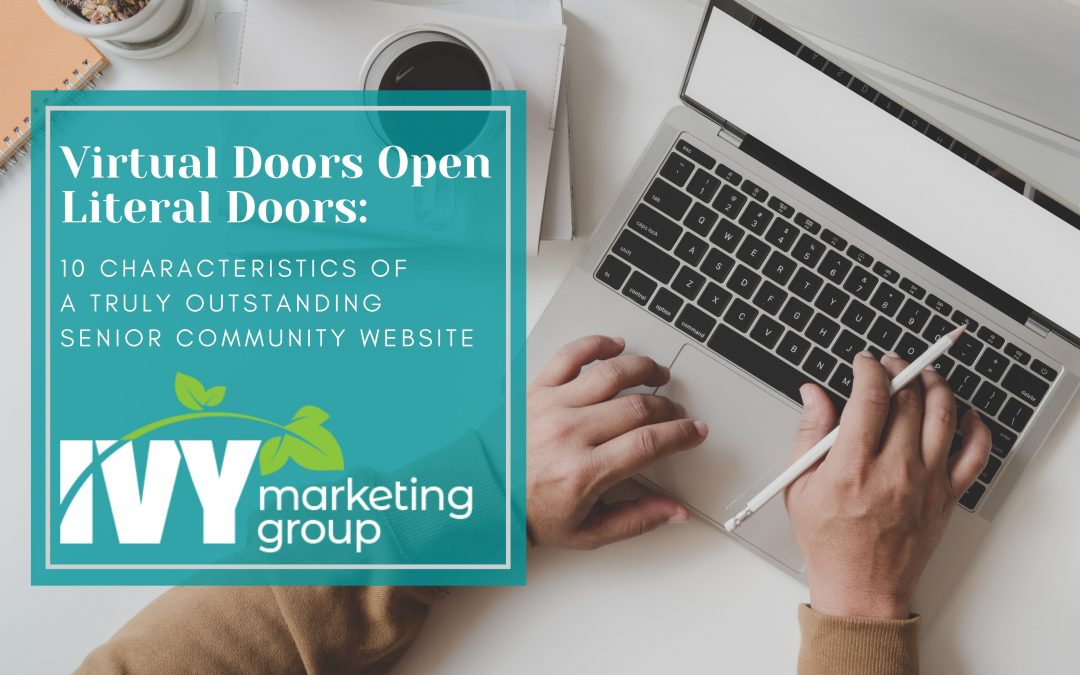
Virtual Doors Open Literal Doors: 10 Characteristics of a Truly Outstanding Senior Community Website
The very first web page went live 30 years ago. It was dedicated to Tim Berners-Lee’s World Wide Web project. While it was bland and uninviting, in retrospect, we know that this first URL opened the door to today’s websites, which virtually open the door to the whole wide world.
With nearly two billion websites in existence, the competition to attract the attention of the 4.72 billion web users across the globe is staggering. Unless you’re Craigslist or Wikipedia, whose unattractive physical look is so embedded in public awareness it would be foolish to change design, a modern website needs some curb appeal – and a whole lot more.
Four years ago, we blogged about the all-important home page. A killer home page is still paramount, but let’s take a fresh look at the multiple characteristics of a truly outstanding website – one that visitors will remember and return to time and again, one that builds trust in your brand and leads visitors to take action.
For the purpose of this blog, we will focus on the senior living industry. Indeed, most of the features that make a great senior community site apply to all websites, but the onus on the senior space to provide an exceptional online experience is particularly great. As literal doors have been closed to visitors, virtual doors must do the lion’s share of the work attracting prospects.
Ten Things That Make Your Website Outshine the Rest
- Virtual tours. Because COVID has severely restricted (if not completely prohibited) in-person tours of senior communities, virtual tours of indoor and outdoor spaces, common areas, amenities, and individual apartments are absolutely essential. Engaging online tours are more than still photographs; they are interactive, three-dimensional, and offer a 360-degree perspective – as close to the real thing as if one were walking through your property.
- Navigability. Getting lost in an illogical, disorganized website is like driving in a strange city and not knowing your way around – with one major difference: you can immediately click out of a website, never to return again. A move to senior living is one of life’s major decisions and, unfortunately, one that is sometimes made during crisis. The first point of entry should be an easy, orderly glide through your community. Studies have shown that the eye tracks text in a certain pattern, and visual hierarchy in the arrangement of your site’s elements points to what is most important and how to seamlessly find subsequent content. Main and sub-tabs designed with first-time visitors in mind guide prospects through a well-organized, stress-free visit.
- Clean, simple design. An unfussy, uncluttered design throughout your entire site, but especially on the home page, makes for a pleasant, positive user experience. Simplicity in design is fresh, timeless and soothing. There’s also great business benefit in a simple design, as several studies have shown that minimalism garners more conversions by establishing legitimacy and confidence in a brand. Endless clicking and scrolling is distracting and comes off as amateurish and “salesy.” On that note, if at all possible, avoid sponsored ads on your site.
- Uniform branding. Along with a clean design goes visual uniformity across your entire site, including color schemes, typography, logo, and other graphic elements unique to your brand. “Cookie cutter” designs are a dime a dozen and will do nothing to distinguish you from the nearly 30,000 other senior communities in the U.S.
- Animation and interactivity. Today’s Internet users are seeking an “experience,” particularly now when in-person visits and events at your senior community are limited. Animated and user-driven interactive elements bring life to your site and create memorable journeys throughout your pages and in your visitors’ minds. These elements also increase engagement with your community and more clicks to discover what’s around the next corner, so to speak.
- Readability. Small type and hard-to-read fonts are a no for any website, especially those serving older adults whose eyesight may be compromised. A simple, legible font scheme (consistent across your entire site) will serve your visitors’ needs and keep them engaged. It will also lend a more professional, sophisticated appearance, establishing trust and credibility in your brand.
- Great Content. You can use the most awesome typestyle and graphics in the world, but without great content on your site, it may as well be gobbledegook. At its core, the “king” – content – is information that benefits your audiences on its own merit – a takeaway, so to speak, that is meaningful regardless of a lead. Great content creates a positive connection between you and your visitors, the ripple effects of which can be boundless.
- Response Time. Sites that load slowly will be abandoned quickly. Optimal load speed is under three seconds; 40 percent of consumers will reportedly abandon a site if it takes longer than three seconds to load. Response time is a function of underlying infrastructure (e.g., a good content delivery network) and design element choices, among other things, and it is essential not only to keeping visitors on your site, but good SEO.
- Mobile friendly. A whopping 90 percent of Internet users across the globe access the web from their mobile devices. Websites that adapt to whatever device one is using allow for significantly greater reach and more shareability among visitors. In essence, you can’t survive without a mobile friendly website.
- Expert designers. Achieving all of the above is a tall, but very necessary order. It is not a layman’s endeavor, nor the work of a pre-fab template. Professionals trained in web design and management on both the front and back ends are a must for a truly outstanding website.
IVY’s team of experts in the senior living space can bring excellent web content and design to life, bringing prospects to your virtual community and in your literal doors.
Contact us today at 630-790-2531 or visit www.ivymarketing.com.
IVY MARKETING GROUP. COME GROW WITH US.
